 image by Željko Heimer,
18 October 2007
image by Željko Heimer,
18 October 2007
Last modified: 2014-04-11 by rob raeside
Keywords: austro-hungarian empire |
Links: FOTW homepage |
search |
disclaimer and copyright |
write us |
mirrors
See also:
Since the 18th century the Austrian tribar was established as the naval flag,
and the same flag was also used as the only flag by the civil and government
vessels until 1848 when the Hungarian tricolour was established, and the
Hungarians insisted it be used at least in their part of the state. The
Ausgleich of 1869 introduced a new double flag as the merchant ensign, but the
unfortunate inconclusive wording of the treaty left opened questions of the use
of that flag on inland rivers and by the government ships (like customs and
other authorities). The Hungarian side insisted on the use of the
red-white-green tricolour, the Austrian side was kind of indifferent to the
issue and the military authorities were insistent on the unique merchant
practice and kept trying to remove the war ensign from civilian use. However,
the issue remained ever unresolved until the breakup of the country with the end
of the World War.
Željko Heimer,
18 October 2007
Ensign in 1786
 image by Željko Heimer,
18 October 2007
image by Željko Heimer,
18 October 2007
Ensign in 1894
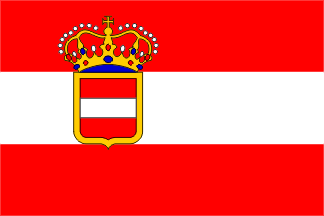 image by Željko Heimer,
18 October 2007
image by Željko Heimer,
18 October 2007
The Austrian red-white-red tribar with a crowned Austrian coat of arms was
introduced on 20th March 1786 as the naval ensign for the ships of the Monarchy
in 1786. This was prescribed also as the jack. It was used also by all merchant
ships until 1869, when a new merchant flag was introduced and this tribar was
prescribed to be exclusive flag of the war (naval) ships. However, the flag was
not dropped from use - on the Austro-Hungarian ships navigating on the Danube
while in Austrian part of the Monarchy and by the government ships on the
Austrian part of the Adriatic, even if numerous attempts were made by the Naval
department of the State Ministry of War to break up this practice. In the 1894
the new graphic layout was prescribed confirming the stylization that was
already present in practice. A new war ensign was prescribed in 1915, but was
not implemented in use due to the war conditions.
This ensign was also
granted for use to the members of the imperial and royal yacht squadron (k. u.
k. Yachtgeschwader) with a special grant.
Željko Heimer,
18 October 2007
The 1869 Ausgleich ("agreement" or "compromise" between Austria and
Hungary that created the dual system) introduced a new merchant ensign "for the
merchant ships at sea and the ships of inland (river) navigation abroad". The
flag is a horizontal tricolour composed of red-white-red Austrian and
red-white-green Hungarian colours so that the bottom stripe was vertically
divided into red hoist and green fly half. At the middle of the hoist half is
set the crowned Austrian coat of arms, as in the war ensign, and in the middle
of the fly half is set the Hungarian coat of arms topped with the Crown of St.
Stephen.
In the good tradition of heraldry, the artwork of the coats of
arms was relatively widely interpreted, so many designs of small artistic
differences have been in use and probably even more differences were shown in
various contemporary (and later) sources. Here are given a few as illustration:
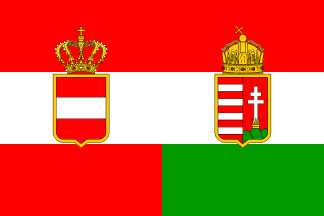 image by Željko Heimer,
18 October 2007
image by Željko Heimer,
18 October 2007
Fflag layout as pictured in the 1869 official gazette [No. 28 Kundmachung]
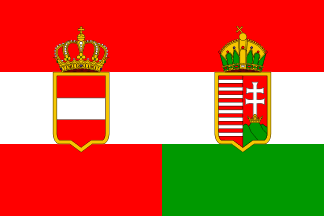 image by Željko Heimer,
18 October 2007
image by Željko Heimer,
18 October 2007
From the 1896 gazette [No. 233 Kundmachung], [note the incorrect number of stripes in the Hungarian coat of arms!]
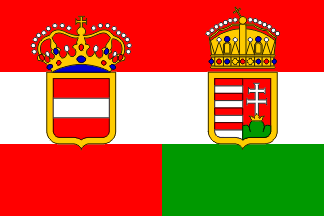 image by Željko Heimer,
18 October 2007
image by Željko Heimer,
18 October 2007
One of the numerous stylized designs used in practice (notice simplified crowns and similarity with the naval ensign design). The simplification of the crowns went significantly further, especially in cruder (cheaper?) productions. Some other contemporary sources showing slightly different artistic designs include [US Navy 1862], [US Navy, 1899], [Heyer, 1883], [HM Stationery Office, 1907] and afterwards [Neubecker, 1939] to mention a few.
However, the exact wording of the Ausgleich was rather vague in this
regard and was the source of all subsequent problems. The dual merchant ensign
was prescribed by it for the seas only - so Hungarians interpreted it so that
they insisted that the Austrian-Hungarian ships on the Danube in the part under
Hungarian jurisdiction fly the Hungarian national tricolour, while the flag in
the Austrian half of the Danube was at first not clearly established, and the
war ensign was continued to be used, but the dual ensign was finally introduced
there in 1894. Introduction of the dual ensign for the government ships on
Adriatic was also slow.
The following flags are a result of the confusion
produced by the Ausgleich that left unresolved issues of ensign used on
rivers (Danube in the first place) and by government ships. The merchant ships
on the sea, the naval ships and private yachting and motor boats had the issue
clearly resolved, flying either the dual ensign or the naval ensign.
Sources:
- Lothar Baumgartner: "Zur Problematik der
ungarischen Nationalflagge nach dem Ausgleich (1867-1915)", Militaria Austriaca,
VIII. Internationaler Kongress für Vexillologie Sonderdruck, Gesellschaft für
Österreichische Heereskunde, Wien, 1979, pp. 5-12.
- P. Diem: Die Symbole Österreichs, Wien, 1995.
- No. 28. Kundmachung des
Handelsministeriums vom 6. März 1869, über die Einführung einer neuen Flagge für
die See-Handelsschiffe der österreichisch-ungarischen Monarchie.
Reichsgesetzblatt für das Kaiserthum Oesterreich 1869 (13.3.1869), p. 111 (+
plate)
- No. 233. Kundmachung des Finanzministeriums vom 9. December 1896,
betreffend die Einführung der Flagge für die Seehandelsschiffe der
österreichisch-ungarischen Monarchie bei den k. k.
Finanzwachschiffen.Reichsgesetzblatt für die im Reichsrathe vertretenen
Königreiche und Länder 1896 (19.12.1896), p. 751 (+ plate)
- "Flags of
Maritime Nations, from the Most Authentic Sources", U.S. Department of the Navy,
Bureau of Navigation, Washington, 1862. pl. 5
- "Flags of Maritime Nations",
U.S. Department of the Navy, Bureau of Equipment, Washington, 1899. pl. 7
-
Friedrich Heyer von Rosenfeld: "Die See-Flaggen, National und Provincial-Fahnen
sowie Cocarden aller Laender", Verlag der kaiserlich-königlichen Hof- und
Staatsdruckerei, Wien, 1883 pl. 2
- "Drawings of the Flags in Use at the
Present Time by Various Nations", H. M. Stationery Office, Greenwich, 1907. pl.
53 - Ottfried Neubecker: "Fahnen und Flaggen. Eine bunte Fibel", L. Staackmann
Verlag, Leipzig, 1939. pl. 87
Željko Heimer, 18 October 2007
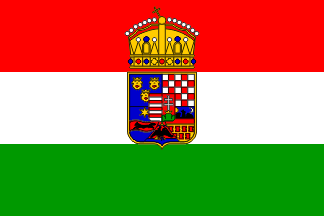 image by Željko Heimer,
18 October 2007
image by Željko Heimer,
18 October 2007
The revolutionary government of Hungary of 1848 proclaimed a new constitution
introducing the modern tricolour based on the historical heraldic colours
red-white-green. Even though the revolution was soon put down, the Hungarian
side continued to call upon the decision of the 1848 Constitution as the basis
for their right to fly the Hungarian colours on ships in the waters under their
jurisdiction. The unclear wording of the Ausgleich gave them here a
strong legal argument that they never gave up. The decision in this sense was
readopted in the Hungarian parliament in 1873 and 1882, and at least on 1st June
1875 the tricolour was being used by the two administrations (financial and
maritime) in Rijeka. The flag with the greater coat of arms (above) is shown by
Baumgartner, though probably the flags in use had the coat of arms hand-painted
and many other artistic variants existed (and presumably versions without the
coat of arms might have been in use as well).
The flag was used by all
Austrian-Hungarian ships on the Danube navigating through the part of the river
under Hungarian jurisdiction, which would first of all be the ships of the
Danube Steam Shipping Company (Donau-Dampfschiffahrts-Gesellschaft,
DDSG).
Baumgartner cites the Austrian writer Fritz von Herzmanovsky-Orlando
(1877-1954) who describes in one of his works how the ensigns on one ship
navigating from Germany on the Danube would be replaced four times until
reaching the Black Sea: leaving Passau, Germany, a ship navigating down the
river to Engelshartszell (i.e. abroad of Austria-Hungary) would fly the dual
merchant flag, then entering the Austrian jurisdiction the war ensign would be
hoisted until reaching Theben/Devin (today in Slovakia). From there the
Hungarian national tricloour would be flown until leaving the Hungarian
jurisdiction [that would be passing though the Iron Gate, I guess?], when the
dual flag would be again hoisted.
Similarly, the ships of the Hungarian
administrative and customs services would, in spite of all the insistence of the
Naval Department, fly the tricolour. At times when the pressure was strongest,
the dual flag would be accepted and the tricolour would be flown at mainmast or
similar, but as it seems each time the giving up was always only for a short
period of time.
The naval authorities pointed out several times that the
Hungarian tricolour is a flag that is not internationally recognized and that
such ships would not have the protection of the international maritime
legislation, upon which the Hungarian side kept replying that the international
regulations are of no interest since the ships are flying that flag at home, and
that the central authorities should take action for the international
recognition of the flag anyway.
Željko Heimer, 18 October 2007
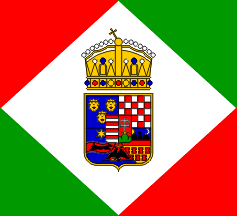 image by Željko Heimer,
18 October 2007
image by Željko Heimer,
18 October 2007
In 1884 the Royal Hungarian Ministry of Agriculture, Industry and Trade notified
the Harbour Admiralty in Pola/Pula that the three new ships of the Royal
Hungarian Maritime Administration - Deli, Bator and Klotilde shall, instead of
the dual ensign, fly the "flag in Hungarian colours" as illustrated: almost a
square flag with white lozenge throughout, the remaining triangles coloured red
(hoist top and fly bottom) and green (hoist bottom and fly top) and containing
the greater coat of arms of the lands of the Hungarian crown, i.e. the shield
quartered: Dalmatia, Croatia, Slavonia, Transylvania (Siebenburgen/Erdely) and
in point Fiume/Rijeka with inescutscheon Hungary (per pale Hungary Ancient and
Hungary Moderne). The shield is crowned with the crown of St. Stephen.
After a relatively strong answer of the Austrian side arguing the lack of
international recognition of this flag, it was followed with a conclusion that
"it must have been a misunderstanding", and the Hungarian Ministry gave up their
initial intention and "explained" that the flag shall be used as administrative
signal (bandiera distinazione) atop the mainmast, and that on the stern
the dual ensign remains in use (even if it seems that the Hungarian ensign was
used until that period). This flag is not mentioned in any further notes between
the ministries, so it seems that it might have not been introduced into
practical use.
Željko Heimer, 18 October 2007
After a lengthy discussion among several involved ministries in 1893/1894
finally agreement was reached on the designs of the administrative signals of
the four administrations with jurisdiction in the Adriatic - as it has been
decided already in 1869. The Emperor even signed them. Until the introduction of
the signals the administrations did not want to use the merchant ensign, as that
would make their ships indiscernible from the civil ships. Therefore they used
either the war (Austrian) ensign or the Hungarian tricolour. However, the agreed
patterns were never introduced into use, the maritime authorities continued with
their previous practice until the breakdown of the Monarchy, while the financial
signals were introduced of different design, in 1897 by the Austrian, and around
1900 by the Hungarian financial administration. Baumgartner shows these signs
with a "perspective" layout of the coats of arms (i.e. the height of the
coat of arms in its fly end is smaller than in the hoist end), following the
originals in Akten des Österreichischen Staatsarchivs/Kriegsarchivs-Präsidialkanzlei/Marinesektion.
Analogous rectangular flags for the chiefs of the administrations were also
adopted to serve as distinction flags when they are aboard the ships.
Željko Heimer,
18 October 2007
The chiefs of the administrations adopted rectangular flags at the same time,
being distinction flags when they are aboard the ships. Baumgartner does not
provide drawings of these, only vaguely describes them as rectangular versions
of the pennants. Based on this I "reconstruct" those - so they should be taken
with a grain of salt.
Željko Heimer, 27 October 2007
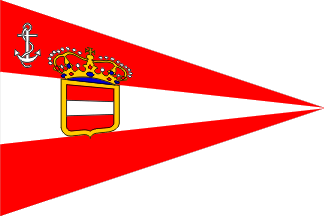 image by Željko Heimer,
18 October 2007
image by Željko Heimer,
18 October 2007
The Austrian maritime administration with headquarters in Trieste and Zadar was
given a triangular tricolour of red-white-red with stripes converging towards
the fly point. In the middle is the Austrian coat of arms topped with a heraldic
crown and in the canton there is a white fouled anchor.
Željko Heimer,
18 October 2007
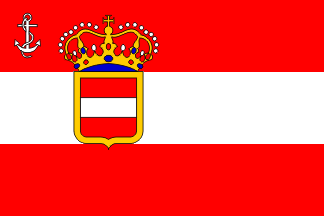 image by Željko Heimer,
27 October 2007
image by Željko Heimer,
27 October 2007
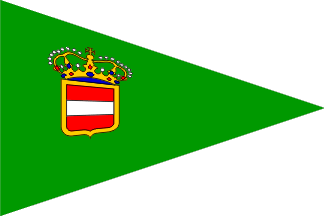 image by Željko Heimer,
18 October 2007
image by Željko Heimer,
18 October 2007
The Austrian financial administration (performing customs inspections) with
headquarters in Trieste and Zadar was given a triangular green flag. In the
middle is the Austrian coat of arms topped with a heraldic crown.
Željko Heimer,
18 October 2007
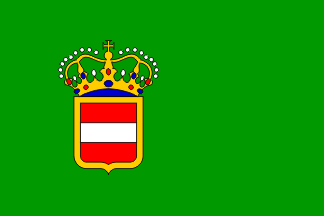 image by Željko Heimer,
27 October 2007
image by Željko Heimer,
27 October 2007
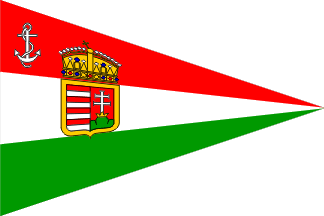 image by Željko Heimer,
18 October 2007
image by Željko Heimer,
18 October 2007
The Hungarian maritime administration with headquarters in Rijeka was given a
triangular tricolour of red-white-green with stripes converging towards the fly
point. In the middle is the Hungarian coat of arms topped with the Crown of St.
Stephen and in the canton there is a white fouled anchor.
Željko Heimer,
18 October 2007
 image by Željko Heimer,
27 October 2007
image by Željko Heimer,
27 October 2007
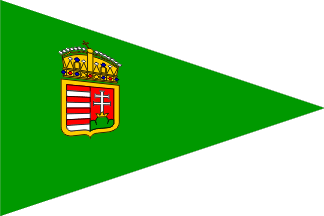 image by Željko Heimer,
18 October 2007
image by Željko Heimer,
18 October 2007
The Hungarian financial administration (performing customs inspections) with
headquarters in Rijeka was given a triangular green flag. In the middle is the
Hungarian coat of arms topped with the Crown of St. Stephen.
Željko Heimer,
18 October 2007
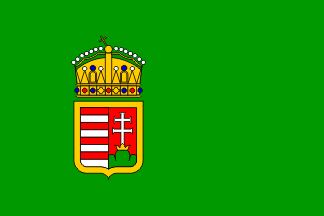 image by Željko Heimer,
27 October 2007
image by Željko Heimer,
27 October 2007
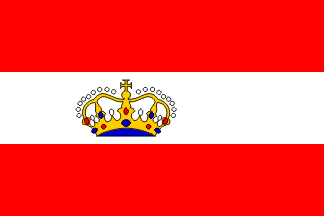 image by Željko Heimer,
27 October 2007
image by Željko Heimer,
27 October 2007
In 1896 the Austrian Ministry of Trade informed the Naval Department that,
according to their wish, it was resolved with an "internal direction" of the
DDSG (sic!) that from now on in the Austrian part of the Monarchy they would use
the dual merchant ensign, and no longer the war ensign. At the same time they
offered, as a compromise towards a global solution, two proposals of the unique
merchant ensign for inland navigation (i.e. on rivers, mainly Danube).
Baumgartner shows one of the two proposals: Red-white-red triband with the crown
off-set to the hoist in the white stripe. The crown artwork is similar to that
used on the top of the coat of arms in the naval ensign. The other of the two
proposals is not published anyway yet, I believe.
Such a flag would be
used on all ships on inland rivers in both state halves. As could have been
easily expected for such a design, soon the Hungarian Prime Minister declined
any possibility for a unique flag, since he said "the matter was unambiguously
solved in Hungary since 1848" and repeatedly requested that the Foreign Ministry
begin the procedure for the international recognition of the Hungarian
tricolour.
Željko Heimer,
27 October 2007
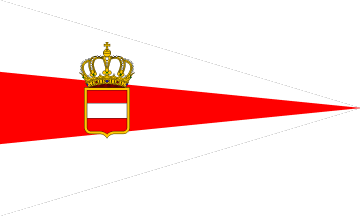 image by Željko Heimer,
27 October 2007
image by Željko Heimer,
27 October 2007
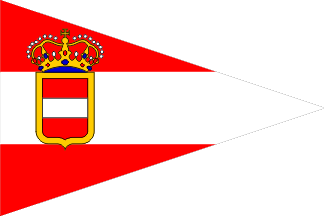 image by Željko Heimer,
27 October 2007
image by Željko Heimer,
27 October 2007
In September 1896 the k. k. Ministry of Finances and the k. u. k. Foreign
Ministry (the k. k. Ministry of Trade was in the meantime dissolved) issued that
all the involved ministries have come to agreement regarding the flags of the
Imperial and Royal Financial Administration. All the previous decisions that
allowed the Administration to hoist the war ensign were invalidated and since
1st January 1897 the Austrian financial ships flew the dual merchant ensign, and
atop the mainmast a pennant as an administrative signal. For this purpose it was
not used the already adopted design of 1893 with which all the sides were
concordant, but a triangular pennant of white-red-white stripes with the coat of
arms and the crown. (No 233; Baumgartner, 1979; Ruhl, 1905)
Some sources
show the red-white-red pennant with horizontal stripes (above, lower image), but
could that be considered an erroneous depiction never actually used? (e.g. HM
Stationery office, 1907)
Željko Heimer,
27 October 2007
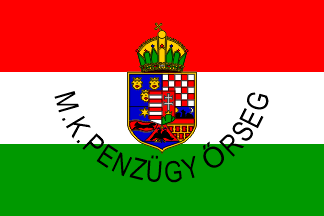 image by Željko Heimer,
27 October 2007
image by Željko Heimer,
27 October 2007
The ships of the Royal Hungarian Financial Administration in Rijeka still
used on the stern the Hungarian national flag. As the administrative signal at
the mainmast here was also not introduced the pattern adopted in 1893, but the
one with the arched inscription "M.K.PENZÜGY ÖRSEG" (= Royal Hungarian Financial
Administration). The real date of the introduction of this pennant is not known,
but must have been between 1898 and 1908 (Baumgartner, 1979; Ruhl, 1905). The H.
M. Stationery Office 1907 flag book reports (incorrectly) inscription to be
"M.K.PÈENZÜGY ÖRSÉG".
Željko Heimer,
27 October 2007
- Lothar Baumgartner: "Zur Problematik der ungarischen Nationalflagge nach
dem Ausgleich (1867-1915)", Militaria Austriaca, VIII. Internationaler Kongress
für Vexillologie Sonderdruck, Gesellschaft für Österreichische Heereskunde,
Wien, 1979, pp. 5-12.
- No. 233. Kundmachung des Finanzministeriums vom 9.
December 1896, betreffend die Einführung der Flagge für die Seehandelsschiffe
der österreichisch-ungarischen Monarchie bei den k. k.
Finanzwachschiffen.Reichsgesetzblatt für die im Reichsrathe vertretenen
Königreiche und Länder 1896 (19.12.1896), p. 751 (+ plate)
- Moritz Ruhl: "Flaggenbuch",
Reichs-Marine-Amt, Berlin, 1905. pl. II-49 pl. II-49, II-49-n
- "Drawings of
the Flags in Use at the Present Time by Various Nations", H. M. Stationery
Office, Greenwich, 1907. pl. 56